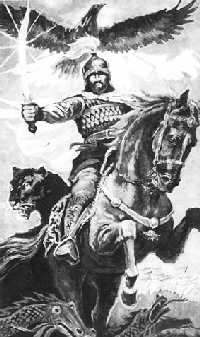|
Hero Epic: Manas of the Kirgiz
( 2005-09-13 )
Manas of the Kirghiz people is famous as one of the three greatest Chinese epics, together with TibetanGesarand MongolianJianggar. Manas also is the name of the epic's eponymous hero.
 About the Epic of Manas About the Epic of Manas
 The epic of Manas, with more than 210,000 lines, is one of the longest epics in the world, 20 times longer than Homer'sOdyssey. It falls into eight episodes, totaling 20 million characters. The epic of Manas, with more than 210,000 lines, is one of the longest epics in the world, 20 times longer than Homer'sOdyssey. It falls into eight episodes, totaling 20 million characters.
It is a patriotic work recounting the exploits ofManasand his descendants and followers, who fought against invaders in the ninth century to preserve Kirghiz independence. The epic dated back to the ninth and 10th centuries, but it was not set down in written form until 1885.
Manasis a trilogy, "a biographical cycle of three generations of heroes, includingManas, his son Semetei, and grandson Seitek."
The nomadic Kirgiz historically experienced many wars and battles with their traditional enemies and invaders. In difficult times when they were defeated by their enemies and exiled to far away lands, as it is the case inManas, people longed for an ideal hero to reunite and protect them.
In traditional Kirgiz epic songs, the main hero should not die. If he dies, he leaves an heir behind to protect his people. Therefore, uponManas' death, his son Semetei continues his legacy, and when Semetei dies, his heir Seitek is born to protect his people. However, the epicManasdoes not end with Seitek.
Although some of the main stories in the epic deal with the 17th and 18th centuries, there are many archaic elements and themes that reflect its ancient origin. As time passed, the "primitive" plot as well as the archaic language of the epic went through many poetic transformations adapting to new historical, socio-economic and religious developments of each century or decade.
|

